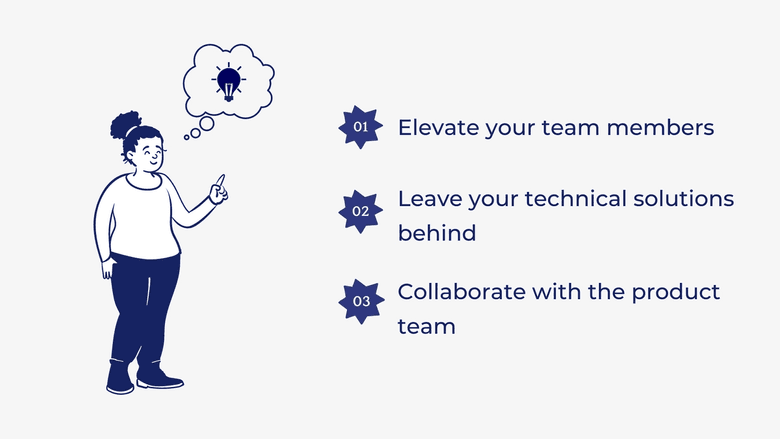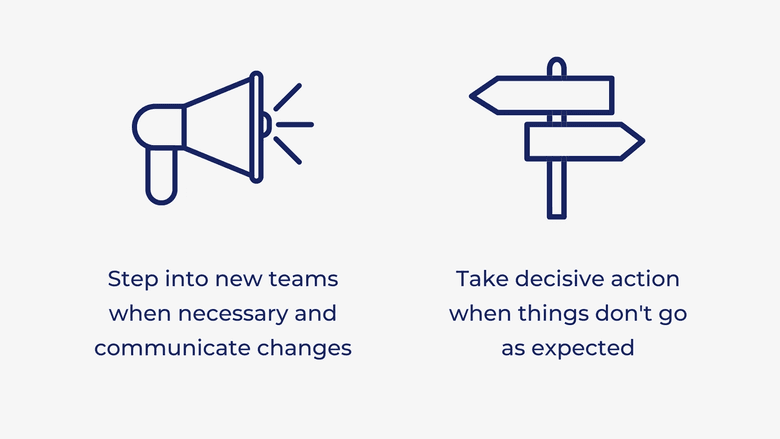3 surprising facts about being a tech lead
A Tech Lead is not just someone who makes YouTube videos.
Most ambitious developers yearn to be promoted to a technical lead or an engineering manager one day.
Tech leads head up a team of developers and take charge of all software development projects, making high-impact decisions about project timelines, technology stacks, and architectural constraints.
What else do they do? These are 5 of their key responsibilities:
- Maintaining a productive work environment for development teams
- Communicating business requirements and assigning work to software development teams
- Representing technical teams (i.e. software developers, engineering teams, etc) on a management or board level
- Developing troubleshooting programs and supervising system modifications
- Recruiting and retention to meet team headcount
Prestige aside, it’s a challenging position and isn’t necessarily meant to be permanent.
Often, an outstanding senior engineer or full-stack developer, with an aptitude for problem-solving and mentoring, is earmarked for the role. They can then decide whether to pursue a technical or managerial career track in the future.
A tech lead’s responsibilities vary substantially between companies. Some are managers, others are mid-level engineers simply “trying out” people management. In certain organizations, tech lead is just another term for software architect. In fact, the role is so amorphous that it’s common for tech leads to wonder how to measure their own productivity and what else they should be doing to help their team excel. Here are three more surprising facts about being a tech lead...
👉 Read next: Software Architect Salary and Role
Your Job Is to Make Everyone Better Than You

Like any leadership role, your job is to elevate the performance of your team members. In software engineering, this entails:
- Establishing a shared vision for the product
- Managing the technical quality of team deliverables
- Ensuring the team uses appropriate engineering practices and invests in continual improvement to tooling.
In large enterprises, these parameters may be predefined by company policy; in a startup environment, you’ll likely have more leeway.
Let go of your own technical solutions
Your main goal is to keep the tech team happy and thriving through hiring and retention, mentoring and coaching, running meetings, and creating effective team processes.
One of the toughest adjustments when transitioning from an individual contributor to tech lead is learning to let go of your technical solutions. Companies don’t hire coders just to tell them what to do; they’re needed for their ability to solve problems and create solutions.
Have a strong relationship with product
Rather than micromanaging the codebase, teach your team how to make good decisions, work around constraints, weigh competing alternatives, and collaborate effectively with other teams -- especially product. Development teams provide crucial infrastructure and services for product teams, so ensuring a smooth collaboration is paramount. In fact, tech leads often co-lead a team or several joint teams together with a product manager, making that relationship even more important.
No "10x engineers" allowed
In software engineering, the “10x engineer” describes a rare breed of full-stack developer who’s purportedly as productive as 10 regular engineers. Someone with those credentials is unlikely to flourish and be a good tech lead or team lead.
Why? Because they’re too focused on learning new technology frameworks or fixing bugs as fast as humanly possible, and they know every line of code that has gone into production. Your job is not to out-program everyone else, but to provide coaching and support when they need it, and make sure they have the right tools and infrastructure to do their jobs.
You Take the Fall When Things Go Wrong

You're the "face" of the tech team
As the face of the team, Tech Leads publicize the team’s triumphs and take the heat when they miss a deadline or the software breaks. Often, this means moonlighting as a manager and an IC. For example, if a senior software engineer abruptly quits, you might need to step in to write code. Servers crashed due to system overload? It’s your job to take it up with the IT admin, communicate these changes to the development team, and provide management with an adjusted production timeline.
The decisions you make around non-functional requirements, service level indicators, and software architecture are so essential to the success of each software project that you’re bound to make a wrong choice or find yourself having to rectify an unforeseen edge case. As a leader, you must be willing to take responsibility, exhibit calm and composure under pressure, and take decisive action to fix the problem.
You're responsible for all outcomes
Even when you delegate a task, you are still responsible for the outcome. The best precaution you can take against failure is to coach, mentor, and cheer on your team members so they can “manage up” and feel trusted to provide their input, even when they disagree with you.
This Job Is Not Meant to Be Your Final Destination

This is a jumping off point
The tech lead role is often designed to be transitional or a jumping-off point for programmers who are too talented to be ICs, but don’t possess the people management experience required to enter management. Or, it may be a recourse for a senior software engineer who isn’t interested in executive management, but still desires a promotion. In fact, tech leads often take advantage of the flexibility of the role to explore their strengths. Are you more interested in being a software architect or a manager? Do you care more about frameworks and technology stacks or writing code?
Use the diverse responsibilities to figure out what you love
Given the intersectional nature of the role -- an overlap between development, architecture, and leadership -- you might initially struggle to balance competing priorities. Some days you’ll spend in back-to-back meetings with executive management, or working alongside HR to recruit new developers. Other days you’ll be busy reviewing changes to the codebase, mentoring junior developers, or assisting with debugging.
Is this role right for you?
Some tech professionals enjoy this balancing act and the variety it offers. Others dislike the people management aspect or the lack of structure or fear their coding skills might atrophy from disuse. Whether you stay on as a tech lead for 10 years, use it as a stepping stone to becoming a CTO or CIO, or prefer to return to the familiar comfort of being an individual contributor, becoming a tech lead represents a unique opportunity to discover your strengths (and weaknesses) and determine where you want to go in your career.
The information provided herein is for general informational purposes only and is not intended to provide tax, legal, or investment advice and should not be construed as an offer to sell, a solicitation of an offer to buy, or a recommendation of any security by Candor, its employees and affiliates, or any third-party. Any expressions of opinion or assumptions are for illustrative purposes only and are subject to change without notice. Past performance is not a guarantee of future results and the opinions presented herein should not be viewed as an indicator of future performance. Investing in securities involves risk. Loss of principal is possible.
Third-party data has been obtained from sources we believe to be reliable; however, its accuracy, completeness, or reliability cannot be guaranteed. Candor does not receive compensation to promote or discuss any particular Company; however, Candor, its employees and affiliates, and/or its clients may hold positions in securities of the Companies discussed.
